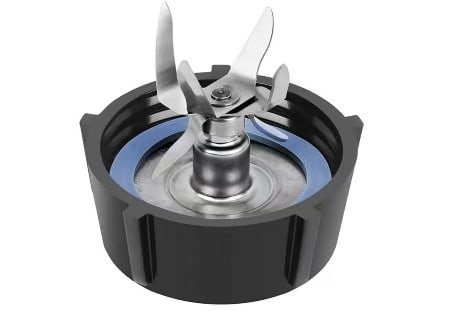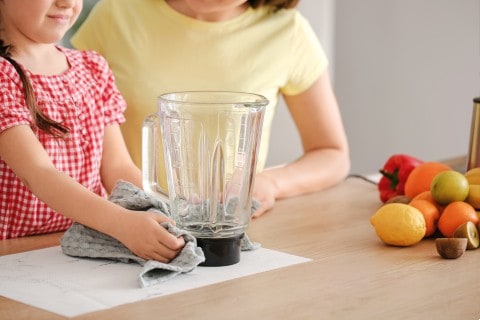Blenders are a common kitchen appliance that can malfunction for a variety of reasons and in a number of ways. One of the most common questions people ask in this regard is “Why does my blender smell?” The answer to this question can involve different variables. Factors such as excessive use, unstable power supply, and lapses in cleaning are just some of the reasons behind smelly blenders.
Most people are concerned because the blender is an important piece of equipment and can really help out in the kitchen. Without a blender, a lot of cooking processes can come to a halt, and you have to spend money either on repairing it or buying a new one altogether. These problems can be resolved if you have sufficient knowledge about common yet pressing issues and their solutions.
In this article, we will discuss some of the odor issues that people frequently face with their blenders. Sometimes, these problems are easy to rectify while in other cases, they can be glaring enough to warrant replacement.
Table of Contents
Why Does My Blender Smell Like It’s Burning?
People can start to panic in case their electrical appliances emit a burning smell. Even with a brand new blender, you can notice a burning smell during the first few times that you use it. One of the most basic factors to understand here is the energy perspective. There are numerous parts within a blender or any other electrical machine that can heat up due to kinetic energy being produced within it. Parts that are made from materials like rubber can therefore emit a burning smell.
The smell emerging from a brand new blender can also be due to lubricants that are used in its manufacture. As the machine is used for the first few times, the excess lubricant is burned off. The odor that results is temporary and doesn’t last long. In these cases, there is nothing wrong with the machine and no reason to panic. However, if the burning smell is accompanied by smoke, you are looking at a completely different situation.
Why is My Blender Smoking?
A blender emitting smoke is a major cause for concern. That effectively means that there is something seriously wrong with your blender. Smoke is a precursor to fire, so if you see smoke emerging from your blender, make sure that you turn it off and pull the plug immediately. This action can even contain a fire at times.

A blender can start smoking due to various reasons. Insects like cockroaches, ants or termites can get into the machine and either die or chew at the wires. Overheating of the wires within the blender due to the accumulation of dust or penetration of water within the machine can also lead to a short circuit that can cause fires. Running a blender for long periods of time like 5 minutes or more straight can cause smoke even if it doesn’t result in a fire.
How to Prevent Blender Overheating
There can be a variety of factors that cause a blender to overheat as discussed above. However, there are a few things that you can do to mitigate the chances of overheating and smoking. The first thing that a user can do is to make sure that the blender is not filled to the brim. Overloading the jug can lead to excessive strain on the machine. As a result, the equipment can eventually overheat and start to emit smoke.
Make sure that you don’t run the blender for more than 3 minutes straight in any case. After you switch it off, let it cool for at least 30 seconds before turning it back on again. At the same time, cleanliness is a crucial factor that needs to be considered. If any liquid spills on the blender, take precautions and clean it up at the earliest. Never leave the blender in any place where there is a risk of insects entering the machine through gaps.
How to Fix an Overheated Blender
The quick answer is that you should cease using it right away. Your burning blender is a danger not only to you but also to the rest of your kitchen because smoke may cause a fire. Let it cool down for as long as feasible. It’s also a good idea to open a window or put on a ventilation fan to limit the chance of inhaling any of the smoke. You should also back away from the machine just as a precaution.
An overheated blender is sometimes an accident that is waiting to happen. In case the overheating doesn’t stop and you see smoke emerging from the blender, ensure that the blender is unplugged. The overheating can be of various components like the blades, motor, O-rings, brushes, and couplers. Some of these parts can be unscrewed and replaced easily at home, while others might require professional repairs.
Causes for Overheating
Blenders are essential equipment in kitchens. Whether you need to make smoothies, sauces or purees, blenders make the job extremely easy. However, all is well until the machine starts to overheat. With so many different components inside the machine, there can be various reasons for overheating. Each piece within the blender can overheat for different reasons and it is important the know the causes as they can come in handy.
Blades
Any blender’s blades have the potential to cause the most issues. Have you ever observed that your blender’s blades stopped rotating while you were using it? This can quickly cause harm to your blender, causing it to overheat. It also produces the warm metallic odor associated with blenders. This happens when the blade’s bearings lock up due to the strain of what you’re processing. It’s also possible that your blades have become dull and are unable to cut through the material you’re attempting to cut, especially when it comes to hard veggies or ice.
Blades are generally simple to repair, so you can just purchase new blades instead of a whole new blender. To begin, make sure you have the blender’s manufacturer and model number. You can use this information to purchase and install a new blade system from the manufacturer or a third party. Unplug the blender first, then unscrew the base from the jar’s bottom. You can now remove the worn parts and replace them in the same order.
Seal
Every blender has a seal of some sort. These seals, also known as a gasket, O-ring, or washer, protect the motor from the upper part of the blender. They are made to prevent any liquid from entering the engine and causing damage. These seals get old, worn, ripped, and hard over time. This prevents them from completely protecting the engine, as even the tiniest crack can allow liquid to enter.
It’s even easier to replace the broken seal than it is to replace the blade. They’re even placed in the same location! The old seal will be there if you follow the guidelines above for the blade. So, if you’re going to repair the blade, you might as well change the seal as well.
Coupler
Couplers are an essential component of any blender. They’re the pieces that go into the jar before you start blending. They are located at the very top of the appliance base. These parts, which are usually constructed of plastic or rubber, might potentially be damaged. Under extreme conditions, they can harden, shatter, deform, and even melt. Couplers are also meant to protect the blender in the event of a failure.
This means they should turn off if another portion of the blender, such as the blades or motor, is overloaded. The installation of new couplers is likewise rather simple. You should be able to remove the old one from the appliance base by gently popping it out or unscrewing it. After that, inspect the area around the coupler for any debris that could hinder the new one. After that, put the new coupler in place.
Motor
All of your blender problems may be traced back to the motor. If a different part is broken or worn, the motor is the one that is put under stress in some way. When the motor is overworked, the result is overheating. Replacing broken blades, seals, or couplers at this time will not undo the harm that has already been done.
If you’ve been under a lot of stress for a long time, your engine may be utterly broken. Sadly, when it comes to changing the engine in your blender, it may be too late. You can try to fix it, but it may be more cost-effective to replace the complete appliance at this time, especially if your blender is inexpensive. If it comes down to it, conduct your study on your new blender to ensure that this does not happen again with that equipment.
Brushes
The brushes are electrically transferring elements inside the blender’s motor. These could be to blame if your motor is overheating and breaking down. When these sections inside the motor become overworked, they emit a distinctive hot metal odor and sometimes smoke.
Brushes are one component of your motor that you may choose to replace. Depending on your model, they may be situated in different sections of the motor, so consult the manual. They should be quite simple to remove once they’ve been discovered. It’s possible that you’ll need a little screwdriver to complete the task. When putting the new brushes in place, they should only go in one manner.
Why Does My Blender Smell Bad?
There are a few different causes for a bad smelling blender. If the electric motor of a blender becomes overheated, it emits a suffocating odor similar to that of burning electrical components. When the device is not correctly fastened to seal any holes between the base of the blender and its top, the overheating is mostly caused by seeping food particles or other fluids.

A stale smell develops when certain parts have trapped food or when they haven’t been washed properly. Regular cleaning is easy, as you can just fill the jar halfway with warm water and liquid dishwashing soap and run the blender for a few seconds. After discarding the soapy water, rinse a couple of times with clean water. Any stubborn stuck-on food may need a bit of scrubbing as well. Learn more about how to clean a blender properly.
Blenders retain a distinct odor, even after they have been washed, for a variety of reasons. For starters, most blender bottles are made of BPA (Bisphenol A) plastic, which is prone to retaining odors and scents, especially if not cleaned on a regular basis. To combat this, after every few uses with regular washing, fill the bottle halfway with vinegar and baking soda and let it sit overnight for more efficient cleaning. For those who use their blender for making bulletproof coffee, the fat from the ghee will be removed thoroughly this way.
An odor may linger in the container depending on the type of ingredients you blend. Simply store the jar without the lid on and see if that does the trick. If that doesn’t help, rinsing the container with a diluted bleach and water solution is also a good idea.


